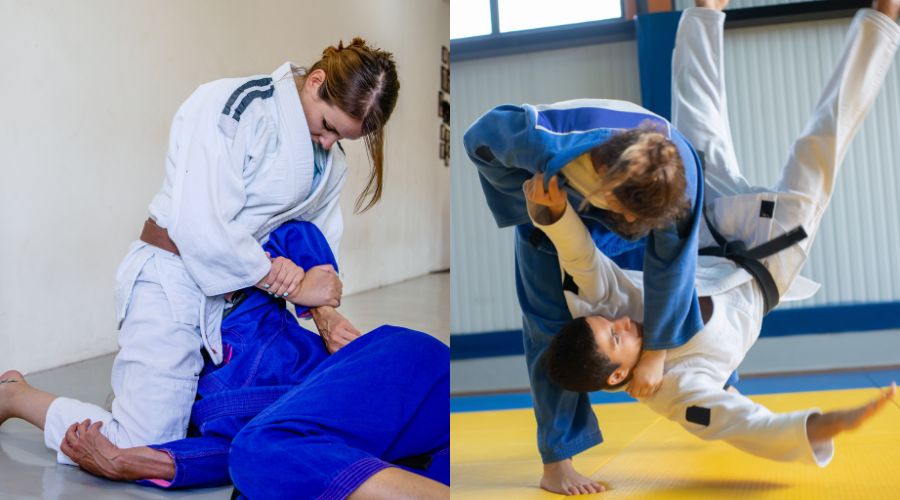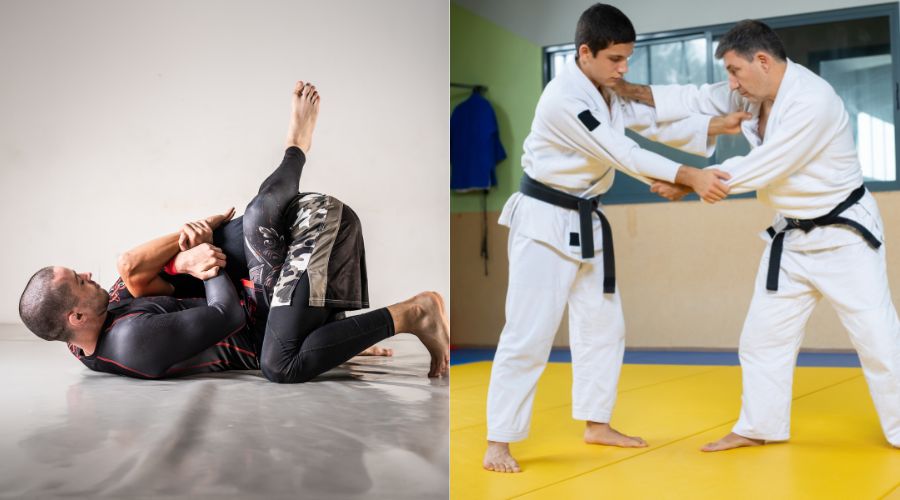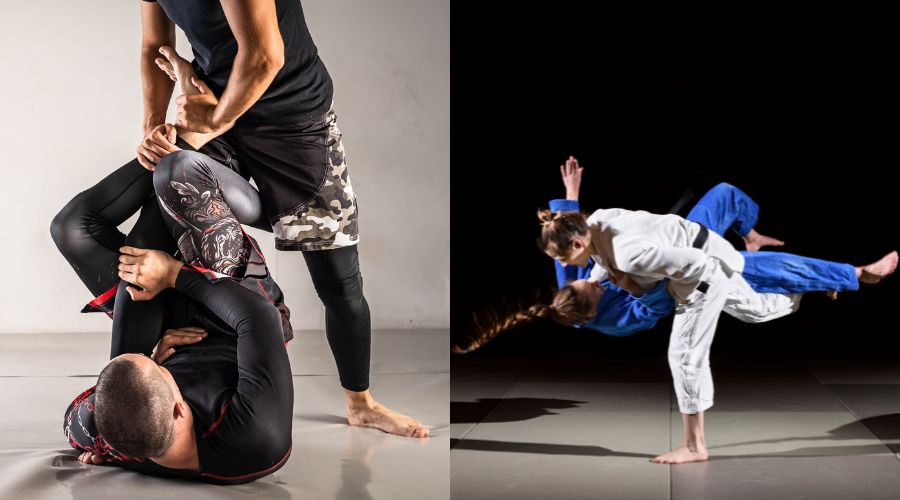Brazilian jiu-jitsu and judo are two of the premier grappling martial arts, sharing a common root and overlapping techniques. However, the closer you look, the more differences you will find. The main goal of both is to control an opponent through grappling techniques, but the approaches are different.
BJJ emphasizes ground fighting techniques like controlling position, joint locks, and chokes, focusing little on how the fight gets to the ground. Judo, conversely, is focused on getting the opponent to the ground with throws and trips. In contrast, ground fighting techniques are less important.
Choosing between BJJ and Judo requires a lot of research. Is the only difference the fighting on the ground, and how do you know which is better for you?
What Is BJJ
Brazilian jiu-jitsu is a fast-growing sport, and martial art focused entirely on grappling. It is a comprehensive system that includes many joint locks, chokes, and other painful holds aiming to incapacitate an opponent on the ground or make him submit.
Throws and takedowns receive very little attention, and the vast majority of time and attention is placed on control on the ground via the application of technique and leverage.
BJJ is derived from judo and, by extension, traditional Japanese jiu-jitsu. Japanese judoka Mitsyuo Maeda brought judo to Brazil in 1914 and opened the academy there.
His students, Carlos and Helio Gracie, started developing their own style, focusing more on the ground portion of the fight. In time, they created the system known as Brazilian jiu-jitsu, with the goal of being a combat system for self-defense and no-rules fights.
The style of BJJ became popular through the exploits of the Gracie family, who defeated countless opponents in Brazil in Vale Tudo fights (no-holds-barred fights).
The big boom in popularity came with the advent of modern MMA through the UFC and the victories of Royce Gracie in three of the first four editions, who showed everyone how important grappling is to real fighting.
Today BJJ is widely used as the primary grappling style used in MMA. Still, it is also a highly developed and tightly regulated sport. As a sport, BJJ is purely grappling with no striking allowed, and its popularity and attendance worldwide are constantly growing.
What Is Judo
Judo is a grappling combat sport and martial art with a heavy focus on throws and trips. The main goal is to perfectly throw the opponent to the ground by disturbing his balance and applying various takedown techniques. There is also ground fighting in judo, where certain joint locks and chokes can be used to submit or control the opponent.
Judo can be called the father of many modern martial arts. Master Jigoro Kano created it in the late 19th century in Japan. Kano was a master of traditional jiu-jitsu but created a style focused on unarmed fighting, live sparring, and drilling. His style quickly became popular among military and law enforcement personnel.
Through Kano’s constant efforts, Judo spread in Japan and worldwide. Many elements common in martial arts, like colored belts and the traditional gi, were first introduced by Kano in his Kodokan Judo.
Today Judo is a very popular grappling combat sport, thanks in no small part to its inclusion in the Olympics in 1964. Olympic sports enjoy great attention from fans and support from governments, and judo has greatly benefited from its status.
Key Differences Between BJJ & Judo

Rules
As always, the rules of a combat sport determine its appearance, tactics, and specifics. While judo and BJJ have many similar techniques, how matches are scored drastically changes how they play out.
Judo matches can be instantly won by scoring an ippon. This can be done in three ways:
- Throwing the opponent with considerable speed and force so they land on their back.
- Pinning the opponent down for 20 seconds
- Forcing the opponent to surrender by one of the few allowed submissions.
Just by these simple rules, you can see that judo favors the art of throwing or tripping the opponent down, resulting in most matches being played out on the feet.
Lesser points are also awarded, and they are called Waza-ri. Two waza-ri points sum up to an ippon (a direct win). Waza-ri is earned in the following ways:
- Throwing the opponent, but he does not fall on his back
- Holding the opponent for more than 10 seconds but less than 20.
A key point in judo’s rules is they do not allow grabbing the legs, which effectively bans wrestling takedowns like the single and double-leg takedowns. The submissions permitted in competition judo are also limited. They include only joint locks to the elbow and chokes without neck cranks.
BJJ has a very different scoring system, which makes it very different from judo. The only way to suddenly win a match (outside of disqualification) is by applying a successful submission.
BJJ competitions separate participants by belt rank, and there are different restricted techniques at each grade. Still, at the higher level, all submissions are allowed. If neither of the participants can make the other quit, the winner is decided by the accumulation of points awarded for certain moves.
- 2 points for a takedown
- 2 points for obtaining a knee mount position
- 2 points for a sweep
- 3 points for passing the opponent’s guard
- 4 points for obtaining back control
- 4 points for full mount control
As you see, takedowns score very little and cannot win you a match. This is why BJJ matches are played entirely on the ground, aside from the brief starting moments.
Techniques
BJJ is all about control and submissions. Positioning and leverage are key to applying all the techniques used in BJJ. The different guard positions are crucial, as every guard has different options on offense and defense.
But where BJJ shines are the submissions. The martial art has countless joint locks, chokes, strangulations, twists, and cranks that will force someone to admit defeat or suffer severe injury.
Judo techniques are more formally separated into different categories.
- Nage waza- throwing techniques
Throwing techniques are further separated into standing techniques and sacrificing techniques.
- Katame waza- grappling techniques
Grappling techniques are divided into holding and pinning, strangulation, and joint techniques.
- Atemi-Waza- Striking techniques
Striking techniques are just formally a part of judo and not practices outside of kata training.
There is a big difference between the original techniques used in judo and those found in today’s sports rules. Gradually, many moves were removed from the sport to make it safer, more viewer-friendly, and more differentiated from western wrestling.
So many more techniques were initially a part of the martial art, like takedowns that included leg grabs and significantly more submissions. They are still practically a part of Judo. Still, their competition ban means very few dojos practice them consistently.
Belt System
The colored belt system was first introduced to martial arts by Jigoro Kano in Judo and has been widely adopted by many martial arts. Both judo and BJJ use it, but there are some differences in the number of belt colors in each style.
The judo grading system starts with kyu ranks before the black belt and dan grades after. The kyu ranks have a colored belt for each in the following order: white, yellow, orange, green, blue, and brown. Then, once a judoka earns the coveted black belt, he starts climbing the dan system from 1 to 10.
BJJ has a similar system, but the belts are fewer, meaning there is more time between earning a new belt. To ease this transition, a system of stripes awarded to each colored belt is often used. The belt ranks in BJJ are white, blue, purple, brown, and black. Similarly to the dan system in judo, black belts in jiu-jitsu are ranked in degrees.
Equipment
The equipment in BJJ and judo is very similar. Both use a gi, derived from the traditional Japanese kimono. They consist of a jacket and trousers held together by a colored belt.
The differences are subtle and are in the materials used. BJJ gis are heavier and more durable because they must withstand more punishment. On the other hand, judo uniforms are thinner and lighter. Judo gis also tend to have baggier sleeves.
Overall, there are many manufacturers and many different models covering a wide range of requirements from practitioners in both sports, so it depends more on the model and preference than on the sport.
There is another form of BJJ with ever-growing popularity that does not use the traditional uniform. This type of BJJ is called no-gi and is done only in compression shirts and no-gi shorts, which cannot be grabbed or manipulated while grappling.
BJJ vs. Judo For MMA

Both BJJ and judo have proven themselves good for MMA. Still, jiu-jitsu is more effective and has drastically more representation.
When BJJ master Royce Gracie won the first UFC events, many people chose the style as their main ground fighting system. While other styles like wrestling and judo have since succeeded in the cage, BJJ remains MMA’s most commonly used grappling style.
Judo has had much fewer crossover champions reap success in the cage. However, Ronda Rousey, Satoshi Ishii, and Yoshihiro Akiyama have popularized the style as a good base for MMA. The throws, trips, and ability to disbalance opponents from the clinch are where judo shines in the cage.
Modern MMA has evolved a lot since the early days, and no single style is enough to win. BJJ and Judo teach great things that can be used in MMA, but in all cases, the techniques and strategies must be modified to match the reality of cage fighting.
BJJ vs. Judo For Self-Defense

The comparison between BJJ and Judo for self-defense is very similar to MMA. BJJ has a stellar record in street fights. After all, it was created for that purpose and has been proven effective repeatedly. But it still has some drawbacks in real-life situations, the biggest of which is its ineffectiveness if there is more than one opponent.
Then BJJ has no options on the feet, and if an opponent is not easy to take down, there is nothing BJJ can do about it. Additionally, sports BJJ has created some habits and tactics that are not only not suitable for self-defense but are outright dangerous when strikes are involved.
Judo’s strength lies in the clinch and throws, which are excellent for real-world altercations. Throwing the opponent with force on a hard surface is a sure way to end the fight immediately. While limited, the submissions in judo are more than enough against untrained opponents, so you might say judo and BJJ are equal for self-defense.
The ability to control a person and choose the level to which you want to hurt him makes law enforcement and military personnel preferred, attesting to the real-life effectiveness of judo and BJJ.
Who Would Win Between BJJ and Judo?
There have been and still are many matches between judokas and BJJ practitioners. Since the beginning of BJJ, the two martial arts have crossed paths, and early on, they both showed equal proficiency on the ground.
But the sports aspect of judo and the increasingly limited rules have led to the removal of many techniques, leaving judo ill-equipped on the ground against more well-rounded grapplers.
This is why BJJ usually wins the sparring or match once the fight gets to the ground. Many judo throws leave the back exposed. Since a free grappling match does not end when someone is thrown but only when one submits or cannot continue, these throws, which are the main skill of judokas, offer too high a risk for too low a reward.
This is not to say judokas cannot win against BJJ guys. Still, if they are matched under free grappling rules or no rules at all, for that matter, BJJ usually wins.
